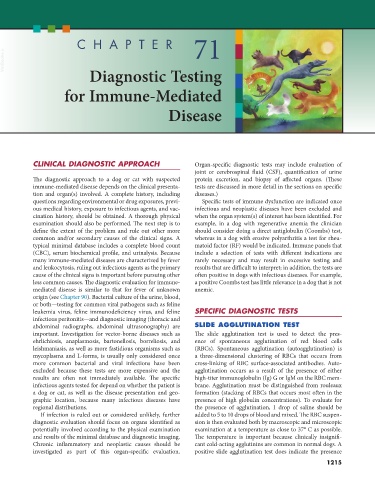Page 1243 - Small Animal Internal Medicine, 6th Edition
P. 1243
CHAPTER 71
VetBooks.ir
Diagnostic Testing
for Immune-Mediated
Disease
CLINICAL DIAGNOSTIC APPROACH Organ-specific diagnostic tests may include evaluation of
joint or cerebrospinal fluid (CSF), quantification of urine
The diagnostic approach to a dog or cat with suspected protein excretion, and biopsy of affected organs. (These
immune-mediated disease depends on the clinical presenta- tests are discussed in more detail in the sections on specific
tion and organ(s) involved. A complete history, including diseases.)
questions regarding environmental or drug exposures, previ- Specific tests of immune dysfunction are indicated once
ous medical history, exposure to infectious agents, and vac- infectious and neoplastic diseases have been excluded and
cination history, should be obtained. A thorough physical when the organ system(s) of interest has been identified. For
examination should also be performed. The next step is to example, in a dog with regenerative anemia the clinician
define the extent of the problem and rule out other more should consider doing a direct antiglobulin (Coombs) test,
common and/or secondary causes of the clinical signs. A whereas in a dog with erosive polyarthritis a test for rheu-
typical minimal database includes a complete blood count matoid factor (RF) would be indicated. Immune panels that
(CBC), serum biochemical profile, and urinalysis. Because include a selection of tests with different indications are
many immune-mediated diseases are characterized by fever rarely necessary and may result in excessive testing and
and leukocytosis, ruling out infectious agents as the primary results that are difficult to interpret; in addition, the tests are
cause of the clinical signs is important before pursuing other often positive in dogs with infectious diseases. For example,
less common causes. The diagnostic evaluation for immune- a positive Coombs test has little relevance in a dog that is not
mediated disease is similar to that for fever of unknown anemic.
origin (see Chapter 90). Bacterial culture of the urine, blood,
or both—testing for common viral pathogens such as feline
leukemia virus, feline immunodeficiency virus, and feline SPECIFIC DIAGNOSTIC TESTS
infectious peritonitis—and diagnostic imaging (thoracic and
abdominal radiographs, abdominal ultrasonography) are SLIDE AGGLUTINATION TEST
important. Investigation for vector-borne diseases such as The slide agglutination test is used to detect the pres-
ehrlichiosis, anaplasmosis, bartonellosis, borreliosis, and ence of spontaneous agglutination of red blood cells
leishmaniasis, as well as more fastidious organisms such as (RBCs). Spontaneous agglutination (autoagglutination) is
mycoplasma and L-forms, is usually only considered once a three-dimensional clustering of RBCs that occurs from
more common bacterial and viral infections have been cross-linking of RBC surface-associated antibodies. Auto-
excluded because these tests are more expensive and the agglutination occurs as a result of the presence of either
results are often not immediately available. The specific high-titer immunoglobulin (Ig) G or IgM on the RBC mem-
infectious agents tested for depend on whether the patient is brane. Agglutination must be distinguished from rouleaux
a dog or cat, as well as the disease presentation and geo- formation (stacking of RBCs that occurs most often in the
graphic location, because many infectious diseases have presence of high globulin concentrations). To evaluate for
regional distributions. the presence of agglutination, 1 drop of saline should be
If infection is ruled out or considered unlikely, further added to 5 to 10 drops of blood and mixed. The RBC suspen-
diagnostic evaluation should focus on organs identified as sion is then evaluated both by macroscopic and microscopic
potentially involved according to the physical examination examination at a temperature as close to 37° C as possible.
and results of the minimal database and diagnostic imaging. The temperature is important because clinically insignifi-
Chronic inflammatory and neoplastic causes should be cant cold-acting agglutinins are common in normal dogs. A
investigated as part of this organ-specific evaluation. positive slide agglutination test does indicate the presence
1215

